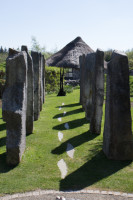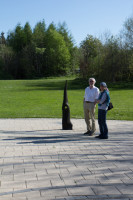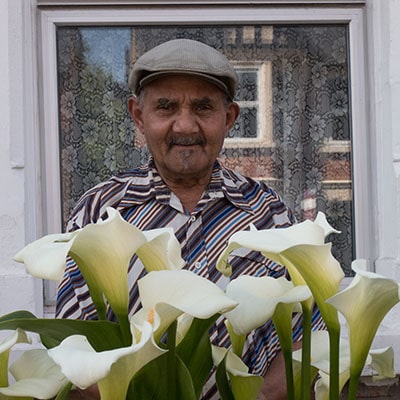Celtic mysteries and standing stones at Brigit’s Garden
Its a while since I’ve been to Ireland, but I took a 60th birthday trip at the end of April. Its home to my mothers side of the family (Hegarty, Co. Cork) so it always feels like a bit of a homecoming. The Irish are earthy, but on the whole not great gardeners. Staying in Co Galway and enjoying glorious weather in Commemara and out on Aran, it was the ideal time for touch of garden exploration.

The Craggy Island Tourist Office were most helpful and we found ourselves at Brigit’s Garden on the edge of Connmemara about 15 miles out of Galway. Part visitor attraction part spiritual retreat, yes the two do mix, they do a roaring trade in the American ‘Spiritual Tourism’ market, it is certainly a garden like no other. St Brigit was the 6th Century Abbess of Kildare and the name means ‘exalted one’. She has three representation in the Irish tradition, as patron saint of midwifery/fertility, of poetry and of the forge (iron-smithing). Quite a multi-tasker.
The gardens, which are celebrating their tenth anniversary this year, are based around the Celtic cycles of the year with four gardens representing the Celtic festivals of Samhain, Imbolc, Beltaine and Lughnasa. Anyone who has read my book ‘Spilling the beans’ will know all about these of course. Centred around a roundhouse used for everything from weddings to meditation, the gardens are absolutely stunning. This is not a garden in the English tradition of Hidcote or Great Dixter, but something uniquely Irish with a grass mound earth mother in Samhain, ‘a sleeping woman representing the earth in its winter rest’, a sculpture of the three faces of St Bridgit in the Imbolc sunken garden, a grassy circle for dancing in, enclosed by standing stones, in Lughnasa and most extraordinary of all, a remarkable set of gigantic granite standing stones marking a processional way to an ancient throne made of 5,000 year old bog oak and yew. The standing stones look like they could have been there for thousands of years. In fact low loaders and large diggers brought them in and erected them just a decade ago.
If it all sound a bit New Age, it proves that context is all, because the gardens and the surrounding nature trail stretch over an 11 hectare site which is imbued with a strong sense of the mystic and the Celtic. It is not far from Loch Corrib and the area is mainly limestone, but glacial eskers wind their way across the landscape, including the site. A ring fort surrounded by ancient hedges is within the site and the trail includes some remarkable collections of plants and trees including right beside each other a mature ash, oak and a gigantic goat willow, all long preceding the construction of the garden. These natural features have been skillfully combined and enhanced with newly created wild spaces such as a ‘lochan’ (small loch), an esker wood and meadow and sculptures and points of interets such as a ‘dream shelter’ and the largest sundial in Ireland (pictured).  The love of the natural, the wild and the spiritual are well served, but so too are more prosaic tastes in the cafe, shop and visitors centre. Ireland’s equivilent (roughly) of Prue Leith, Georgina Campbell recommends the food and the gift shop is stocked with an impressively expensive range of goods, doubtless aimed at visitors from Southern California (or south Dublin).
The love of the natural, the wild and the spiritual are well served, but so too are more prosaic tastes in the cafe, shop and visitors centre. Ireland’s equivilent (roughly) of Prue Leith, Georgina Campbell recommends the food and the gift shop is stocked with an impressively expensive range of goods, doubtless aimed at visitors from Southern California (or south Dublin).
None of this would have happened without the energy and commitment of founder Jenny Beale, who slightly ruefully told me that the years of planning and construction (she is pictured in the 10th anniversary time line driving one of the diggers in the early construction days) had been the most fun and that worries about visitor numbers, (the crash of the ‘Celtic Tiger’ less than three years after is opening didn’t help long term financial sustainability) wedding bookings and resolving car parking problems, had slightly taken the gloss off the excitement and the sense of a spiritual adventure of the early days. For Lord and Lady Muck though, none of that mattered as we plunged into the unexpected delights of a cornucopia of Celtic mysticism and horticultural experimentation.

